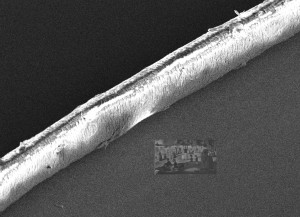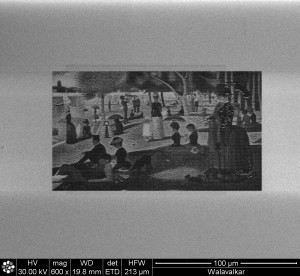After reading the latest newsletter (received via email on March 20, 2023), featuring Scott Billings’ talk ‘Latest Life’, from the University of British Columbia’s (UBC) Belkin Gallery I was reminded of a book produced at the nanoscale back in 2009 (May 21, 2009 posting; scroll down to the final paragraph) and which I wrote about again in 2012 (October 12, 2012 posting) when ‘Teeny Ted from Turnip Town’ was added to the Guinness Book of Records as the world’s smallest book. (‘Teeny Ted’ also has a Wikipedia entry.)
The March 20, 2023 Belkin Gallery (also known as the Morris and Helen Belkin Art Gallery) newsletter is promoting the next Ars Scientia events (the information can also be found on this webpage),
We hope you’ll join us this spring for talks and presentations related
to our ongoing research projects in art and science, and the
Anthropocene. Over the past years, we have developed a deep and
abiding interdisciplinary research practice related to these themes,
working with diverse disciplines that are fortified through oppositions,
collaborations and the celebration of new perspectives. We have shared
our different fields of experience, expertise and resources to catalyze
meaningful responses to research, pedagogy, communication and outreach,
and in doing so build responses that are more than the sum of their
parts. This methodology of bringing the unique perspectives and
practices of artists and curators to academic units presents an
opportunity to foster new modes of knowledge exchange. In this spirit,
we hope you’ll join us in thinking through these critical areas of
inquiry.Ars Scientia
Building on exhibitions like The Beautiful Brain and Drift, the Ars Scientia research project connects artists with physicists to explore the intersections between the disciplines of art and science. A collaboration between the Belkin, the Department of Physics and Astronomy, and the Blusson Quantum Matter Institute [QMI], [emphases mine] this spring’s artists’ residencies culminate in a series of talks by JG Mair, Scott Billings and Timothy Taylor, followed by a symposium in May with keynote speaker Kavita Philip.
Tuesday, March 28 [2023] at 1 pm [PT]
Artist Talk with Scott Billings
Tuesday, April 4 [2023] at 2 pm [PT]
Artist Talk with Timothy Taylor
Monday, May 15 [2023]
Symposium with keynote by Kavita Philip
…
I have more details (logistics in particular) about the Scott Billings talk, from the QMI Ars Scientia Artist Talks 2023: Latent Life by Scott Billings events page,
Please join Scott Billings for Latent Life, a presentation based on his recent research in the Ars Scientia residency. Drawing from a 1933 lecture in which Neils Bohr asserts that the impossibility of using a physical explanation for the phenomenon of life is analogous to the insufficiency of using a mechanical analysis to understand phenomena of the atom, Billings will discuss his seemingly conflicting dual practice as both visual artist and mechanical engineer. Reflecting upon a preoccupation with the animality of cinematic machine, among (many) other things, Billings will relay his recent direct experience with photonic writing [emphasis mine] at QMI’s NanoFab Lab and the wonderful new conundrum of making and exhibiting micro-sculptures that are far too small to see with the naked eye.
…
Date & time: March 28 [2023], 1:00-2:00pm [PT]
Location: 311, Brimacombe Building (2355 East Mall, Vancouver, BC V6T 1Z4)
For more information on this event, please click here.
Photonic writing and sculpture? I’m guessing the word ‘writing’ in this context doesn’t mean what it usually means. Still, it did bring back memories of the world’s smallest book. I always did wonder about the point of producing book that couldn’t be read without expensive equipment. And now, there’s sculpture that can’t be seen.
I hope Billings’s talk will shed some light on this phenomenon of artists and writers creating objects than cannot be seen with the naked eye. Scientists do this sort of thing for fun but the motivation for writers and artists seems to be about proving something and not at all about play.

